[Updated January 31, 2019]
BEST LEASHES AND COLLARS FOR TRAINING: OVERVIEW
1. Consider your own training philosophy. Be clear with yourself about how you want to train your dog. Writing it out can help you formulate and make a commitment to a cohesive training mission and program.
2. Analyze the tools and methods you currently use. Are they congruent with your philosophy? If so, give yourself a big click and treat! If not, determine where you need to make changes.
3. Be a critical thinker. Filter all tools and techniques through your own training philosophy and mission before adopting them for use with your dog.

We’ve presented many articles in Whole Dog Journal that explain why we promote positive training. The risks of using aversive techniques are many, and these can include the types of tools you use to train. All dog guardians will need to own a leash, and some kind of body restraint tool – a collar, or harness. The types of tools you use in training your dog will shape the nature of that training. You have to decide what techniques and tools are right for training and handling your dog, based on your unique training philosophy.
To help you analyze which tools are most likely to help you without hurting your dog, I’ll share my professional opinions about the tools most commonly recommended by positive trainers, always with an eye to whether their intended function is neutral, reinforcing, or aversive, and how they may be, in fact, perceived by the dog.
[Editor’s Note: The July 2018 issue of Whole Dog Journal includes a new review of a hands-free leash system that works quite well. It includes a leash that we think is adequate, but also allows you to clip any leash.]
Leads and Leashes for Dogs

Basic Leashes
Cotton, leather, and nylon leashes are designed to be neutral, and most dogs appear to perceive them that way, at least initially. If your dog makes a positive association with the leash (leash means walk – YAY!) then it can be used as a reinforcer. Your dog can learn to work (sit) for the leash if he learns that “sit” means the leash appears, which makes a walk happen. If the leash is used as a tug toy (as widely practiced by some agility trainers), then the positive association is “leash means play!” and leash-play is a reinforcer for good or excellent behavior on the agility course.
A leash can also be an aversive, if a dog makes an association between wearing the leash and being punished during training or while walking.
For some dogs, the positive associations of going for a walk or training can outweigh the negative associations of aversive tools sometimes used in walking or training. The dog may still enjoy the activity, although perhaps not as fully as if the aversives weren’t in use.
Stretch Leashes
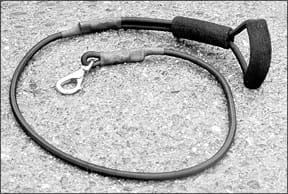
Some dog leashes have built-in elastic pieces; others are comprised of a length of stretchy rubber tubing. The elasticity is meant to absorb the impact that occurs when your dog hits the end of the leash with his body weight. Used carefully, this feature might minimize or prevent damage to your dog’s trachea.
However, these leashes are usually marketed as a way to decrease your dog’s pulling behavior. If it does succeed in doing that (which may be doubtful) it does so by working as a mild aversive. This is confirmed by makers of the products; we found the following statements in ads or packages for products of this type:
“Made from latex that will stretch to more than six feet in length; this stretching continuously, gently corrects your pet.”
“As your dog pulls, the leash stretches, and the resistance your pet experiences teaches them [sic] not to tug anymore.”
“While softening the shock against the dog’s neck, reducing the risk of throat and spinal injuries, the leash delivers an effective correction and release.”
Note the use of terms such as “correction” and “teaches them not to” (our emphasis). These are your clues that the intent of the product is to teach the dog what not to do (not pull) rather than to reinforce the desired behavior and thereby teach him what to do (walk politely). Remember that this is the basic philosophical difference between positive training and training with aversives.
Long Lines for Dogs
Many long-line products are available, from light lines (thin nylon cords) to long lines (flat cotton or nylon) that range in length from 10 to 60 feet or more. Long lines are neutral tools that can be given a reinforcing or aversive association for your dog, depending on how they’re used.
In general, the purpose of a long line is to give your dog more freedom while still maintaining control – very useful when you’re working to generalize a reliable recall, or just to give your dog more exercise. When used with proper safety precautions, I find they fit nicely into my training philosophy. My cautions include:
-
- Long lines should not be used where the line might pose a tripping or tangling danger to other dogs or humans.
-
- Be careful not to let your dog run full-speed into the end of a long line for fear of injury to his spine.
-
- Don’t let go! If your dog runs off into the woods dragging a long line, he can get tangled and trapped.
Retractable Dog Leashes
The retractable leash is commonly seen on trails, in dog parks, and on city streets. Invented in Germany, the leash consists of a plastic handle in which a spring-loaded cord is stored. When the dog moves away from the owner, the cords unreels anywhere from 15 to 30 feet, depending on the model; when the dog moves toward the owner the cord retracts into the handle. The owner can lock the leash at any time by pushing a button on the handle.
While it is neutral by design, as a tool, the retractable leash can be detrimental to training a dog to display polite leash manners. It teaches a dog that pulling against the tension of the spring-loaded cord frequently gets reinforced with greater freedom. A handler can eliminate this inadvertent reward by locking the button, preventing the leash from paying out more cord – then he may as well use a regular leash!
Retractable leashes also send the dog confusingly mixed messages: sometimes you have to stay close; sometimes you can go 30 feet away. This plainly encourages dogs to pull frequently to test the distance allowed at any given time. I don’t recommend their use.
The concerns mentioned above about long lines also apply to retractable leads. Here are some additional caveats:
-
- If the line does get wrapped around dog or human, the narrow cord can cause serious injury – burns, cuts, even amputation of digits.
-
- Unlike a long line, which must constantly be managed, it’s easy for an owner to be inattentive to the retractable leash, since it manages itself. Inattentive users may inadvertently allow their dogs to do inappropriate things, like rudely approaching other dogs and people.
-
- The handle can be cumbersome to hold and is easily dropped. When dropped, the clatter can frighten the dog, and if he bolts, he is chased by the loud, clattering handle. This can pose a disaster for a frightened dog!
Dog Collars
Flat Collars
Buckle or snap; nylon, cloth, or leather; this is a neutral, inoffensive tool. Its primary purpose is for hanging ID tags; providing an attachment for a leash is its secondary use. Of course, “the fool” can misuse a flat collar, but it’s not intended to be used aversively.
The potential for misuse of a flat collar includes forgetting to adjust it as your dog grows (shelters around the country come upon dogs with ingrown collars from time to ti
me – grounds for cruelty charges); yanking on the leash to “correct” your dog; and adjusting it too loosely around your dog’s neck so that he can back out of it and escape.
Flat collars may cause real physical damage to chronic leash-pullers if used for being led. See, “Can a Collar Damage a Dog’s Thyroid?” for more information.
Any collar poses a risk to dogs who wear them in certain situations where they can become entangled, such as while playing at the dog park.
Limited-Slip Collars
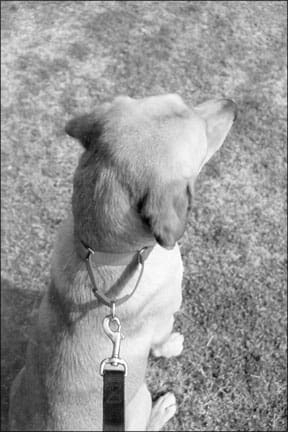
Also called a martingale or Greyhound collar, the limited-slip collar is a flat collar with a loop incorporated into the product so the collar tightens around the dog’s neck if he tries to back out of it – a maneuver that some dogs are quite skilled at performing. Properly adjusted, the collar tightens just to the size of the dog’s neck, and doesn’t cause choking.
Limited-slip collars are especially useful for dogs with narrow heads, who can easily slip out of even a moderately tight collar. I recommend them to some of my clients, and we use one on our Australian Shepherd, who came to us with a well-practiced collar-slipping maneuver in her behavior repertoire.
Head Collars/Halters

Hailed as a positive training tool when it first arrived on the scene in the mid 1990s, the head halter has stirred much discussion among trainers. This tool works like a halter on a horse; it controls the dog’s head, and where the head goes, the body must follow. Some halter proponents suggest that it also mimics the sensation of a mother dog carrying her puppy by the scruff, and that this function calms the dog wearing the halter. I’m not convinced, and I haven’t seen any studies to support this hypothesis.
To the human perception, the head halter appears much more positive than a chain, prong, or shock collar around a dog’s neck. To a significant number of dogs, however, the halter seems to be at least mildly (and in many cases greatly) aversive. Most dogs need to be desensitized to a head halter prior to actual use. If you put it on without a gradual introduction and lots of association with a reinforcer (treats!) you’re likely to get lots of resistance from the dog – pawing and clawing at the halter, bucking against the leash, and attempts to rub it off. Many dogs, even when they’ve accepted it, will still try to rub it off if given the opportunity.
In addition, the head halter tends to suppress behavior and subdue the wearer. People often mistake “subdued” for “calm.” If your dog’s whole personality changes – his tail droops, his eyes lose their sparkle – then you’re looking at a subdued dog, not a calm one. There may be times when that’s useful, but a positive training program generally avoids behavior suppression and encourages the dog to offer behaviors that can be reinforced. There are a number of different models of head halter. Each new design that comes on the scene purports to be more easily accepted by the dog. That tells you something!
This is one of the tools that positive trainers disagree about. I still have head halters in my supply cabinet and may find a rare occasion to use one, but I generally encourage clients to consider other options. Other trainers rely heavily on head halters, and report very little problem with acclimating their clients’ dogs to them. As always, your dog is the one who should decide. If he tells you he finds it aversive, listen.
One of the concerns about head halter use is the potential for injury to the dog’s spine if he lunges at the end of the leash and the halter pulls his head sideways. Until recently, the inventor of the original design stoutly asserted that there were no proven cases of injury related to head halter use. In 2007, one clearly verifiable incident was reported of a dog suffering injury to the nervous system as a direct result of the head halter. The dog recovered.
Dog Harnesses
Walking Harness
A well-fitted walking harness presents little in the way of aversive application. It’s an excellent option to prevent pressure on and damage to the trachea – useful for dogs who have suffered tracheal injury, as well as dogs in general.
Because it is so comfortable, a walking harness can actually contribute to the reinforcement of pulling behavior, especially if the human on the other end of the leash allows the dog to move forward while pulling. Because th
e harness straps distribute pressure across the dog’s chest, discomfort is mild, if it exists at all, and it’s easy for the dog to pull. That’s why they use harnesses for sled dogs!
Another consideration is that the leash usually attaches to a ring on the harness at the middle of the dog’s back, which gives the human very little control of the dog’s front end. Properly used in training, with reinforcement for appropriate leash behavior, a walking harness can complement a positive training program.
Some walking harnesses offer a ring in front, at the dog’s chest, similar to front-clip control harnesses (below). That may be a good choice for the dog who does well in a walking harness but tends to pull.
Take a look at our 2018 Best Dog Harnesses Review if you decide a harness is best for your dog. Get background information on harness types and uses by reading, “Choosing the Right Harness for Your Dog.”
No-Pull Squeeze Harness
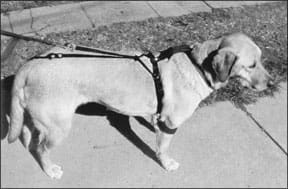
This type of harness has straps that tighten around the dog’s front legs when he pulls. There are several different brands, but they all function similarly. This tool may be mildly aversive, or simply provide a novel sensation that causes the dog to slow down. Either way, in order to be effective, the trainer must reinforce the improved leash behavior provided by the dog’s response to pressure, or the dog tends to fairly quickly learn to pull despite the pressure.
In the models I’ve seen, the leash attaches to a ring on the dog’s back, again giving little control of the front end. Dogs don’t seem to find them particularly aversive, but I’m not sure they’re particularly effective.
Front-Clip Control Harnesses
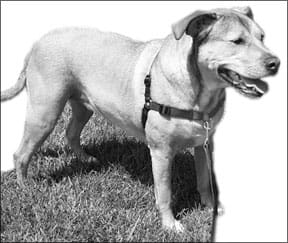
This training tool offers one significant advantage over most walking harnesses: the leash attaches to a ring at the front of the dog’s chest, providing better control of the dog’s front end. The majority of dogs accept this tool without protest, and for many, there is an instantaneous and significant decrease in pulling and increase in owner control. Combined with reinforcement for polite walking this is my positive tool of choice for dogs who pull.
That said, it’s not the right tool for all dogs. A small percentage of dogs do object to the harness. Also, some dogs are difficult to fit, and others experience chafing under the front legs where the straps can rub. Attaching your leash to the front ring of a regular walking harness (some have it, some don’t – shop carefully!) may be a better choice for dogs who have trouble with the front-clip control version.
What’s Best for Your Dog?
Again, you have to decide which equipment best suits your dog. Keep the pros and cons of each training tool in mind, be true to your training philosophy, listen to and respect your dog, and let the sun shine.



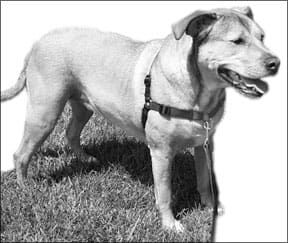

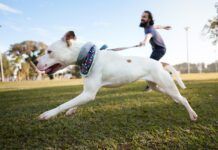

Hi,
Thanks for all the great info you provide. Could you provide some documetation about the 2007 head halter injury you mentioned? In 2012 Sophia Yin wrote an article stating that she had never seen a proven or documented injury caused by a head halter. Of course the details matter greatly as even flat collars can and do cause injuries. Given the number of head halters being used and the number being used by dog owners with little or no training in or understanding of how to use them one would expect a lot more than one documentd case of injury. I’m skeptical but always open to actual evidence. Thanks!
collars are especially useful for dogs with narrow heads, who can easily slip out of even a moderately tight collar. and we use one on our dog to practiced ….